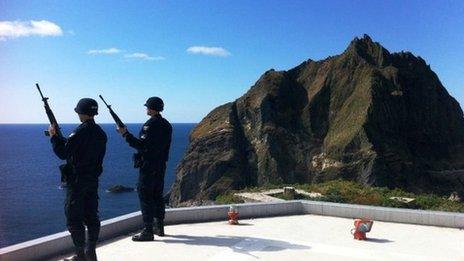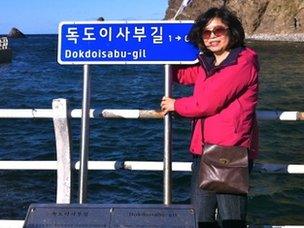Stepping ashore a disputed island
- Published

Security personnel outnumber residents tenfold on the island
From the helicopter window, the tiny islets look bleak and inhospitable. But this rocky outcrop is important enough to push America's two Asian allies apart.
Called Dokdo by South Korea and Takeshima by Japan, the island is claimed by both countries as their territory, and the dispute has strained relations more than ever over the past couple of months.
South Korea controls the island. The BBC was among those given special access, on a government flight.
Battered by strong winds and waves, and more than 80km from the nearest island, it is little surprise that only a handful of people actually live here - despite the government putting in free wifi.
One of the residents, fisherman Kim Seong-do, has lived here for decades.
"Life here is very simple," he said, "and it's different from other fishing grounds - it's very peaceful, there's no one here. I don't even need to put out the nets, I just go and fish and catch what I need."
"It's just me, so life is very tranquil. Though sometimes Japanese journalists call me, and I tell them: don't come here. I refuse to meet them, I'm very stubborn."
Security personnel here outnumber residents 10-1.
'Protect it'
Both Japan and South Korea trace their territorial claims back centuries.
There are some fish stocks and hopes of natural resources, but the appeal for both countries is largely symbolic - a test of the relationship between independent South Korea and its former colonial ruler Japan.
On a windy military base at the top of the island is police chief Lee Kwang-seup.
"As a South Korean citizen I feel strongly that this is our land, and that I need to be here to protect it," he said.
"No other country should lay a finger on it. I'm prepared to be buried here if that's what it takes."
Tensions are running especially high at the moment, after an unprecedented visit to the island two months ago by South Korean President Lee Myung-bak.
Japan responded fiercely to the visit, and the dispute has led to a diplomatic row and a great deal of public anger.
Since then, both countries have increased their efforts to showcase their sovereignty over the rocks.
Down by the island's tiny quay, a ferry arrives, bringing flag-waving South Korean visitors to this unlikely tourist site. There is not much to see here, and the boats only stop for 20 minutes or so, but these tourists have not come to sightsee.

Seoul allows limited tourist access to the islands
One group stands in prayer by the quayside, another dressed in yellow "Dokdo" sweatshirts performs a dance routine.
Some simply wave South Korean flags or have their photographs taken against the steep, jagged cliffs.
"This is our land and I wanted to come here to see it with my own eyes," one woman said, as she stepped onto dry land. "I'm so emotional at the moment, I think I'm about to cry."
"This is Korean land, this is our soil," said another man, "and even if it takes a bit of determination, I think people should be coming here."
Lonely life
South Korea insists sovereignty of the island is not in question. Japan's request to take the issue to an international court has raise hackles here.
Last month South Korea opened a museum showcasing documents it says proves its ownership. It has reportedly set aside money for the coming year to promote its territorial claim abroad.
Back on the island itself, the tourists stand around taking photographs within the small area they are restricted to, around the quay.
When they leave, the police chief himself waves them off - loneliness is the biggest problem here, he said.
Of course there are those who don't mind it. Mr Kim, the fisherman, says he likes the quiet and isolation - not to mention a virtual monopoly on the fish-stocks.
"I'm like the King of the island," he said - another claim of sovereignty to add to the list.
- Published9 September 2012
- Published7 September 2012
- Published10 August 2012
- Published15 August 2012
- Published13 August 2012